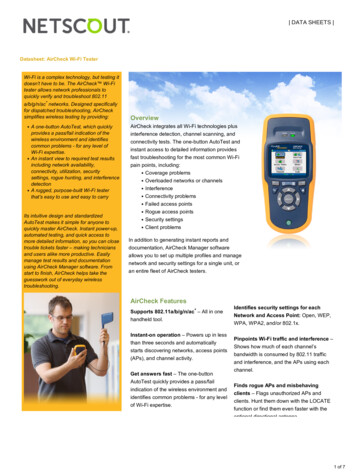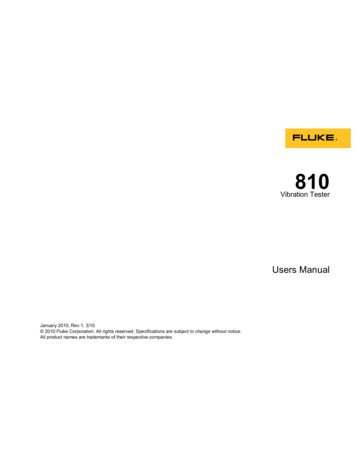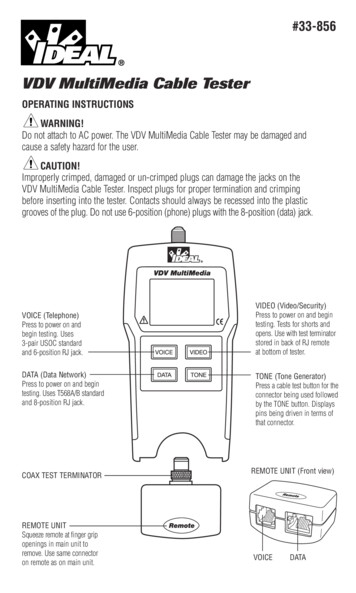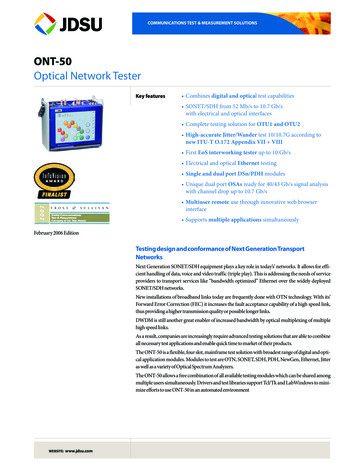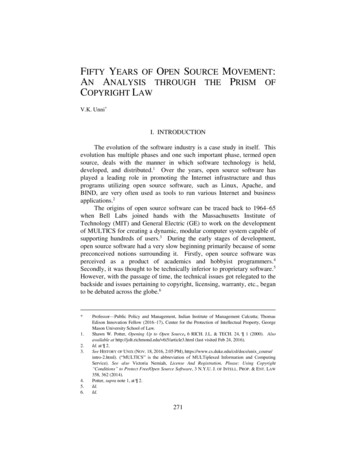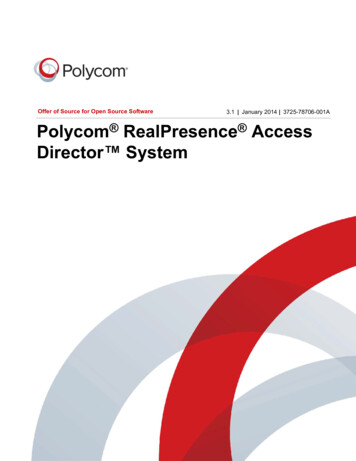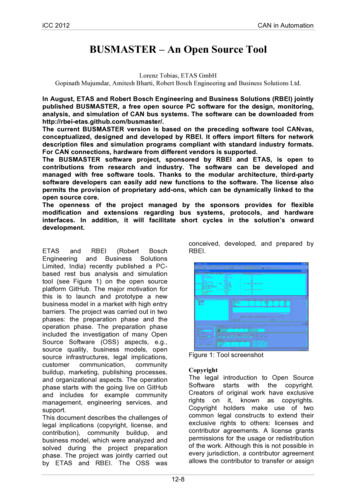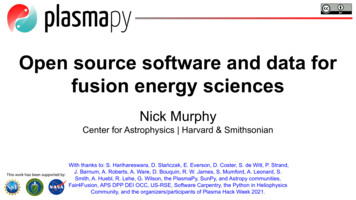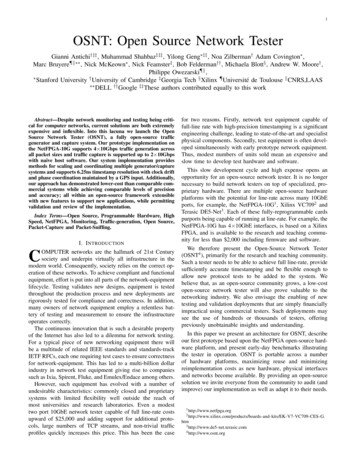
Transcription
1OSNT: Open Source Network TesterGianni Antichi†‡‡ , Muhammad Shahbaz‡‡‡ , Yilong Geng ‡‡ , Noa Zilberman† Adam Covington ,Marc Bruyere¶ , Nick McKeown , Nick Feamster‡ , Bob Felderman†† , Michaela Blott§ , Andrew W. Moore† ,Philippe Owezarski¶ , Stanford University † University of Cambridge ‡ Georgia Tech § Xilinx ¶ Université de Toulouse CNRS,LAAS DELL †† Google ‡‡ These authors contributed equally to this workAbstract—Despite network monitoring and testing being critical for computer networks, current solutions are both extremelyexpensive and inflexible. Into this lacuna we launch the OpenSource Network Tester (OSNT), a fully open-source trafficgenerator and capture system. Our prototype implementation onthe NetFPGA-10G supports 4 10Gbps traffic generation acrossall packet sizes and traffic capture is supported up to 2 10Gbpswith naı̈ve host software. Our system implementation providesmethods for scaling and coordinating multiple generator/capturesystems and supports 6.25ns timestamp resolution with clock driftand phase coordination maintained by a GPS input. Additionally,our approach has demonstrated lower-cost than comparable commercial systems while achieving comparable levels of precisionand accuracy; all within an open-source framework extensiblewith new features to support new applications, while permittingvalidation and review of the implementation.Index Terms—Open Source, Programmable Hardware, HighSpeed, NetFPGA, Monitoring, Traffic-generation, Open Source,Packet-Capture and Packet-Sniffing.I. I NTRODUCTIONOMPUTER networks are the hallmark of 21st Centurysociety and underpin virtually all infrastructure in themodern world. Consequently, society relies on the correct operation of these networks. To achieve compliant and functionalequipment, effort is put into all parts of the network-equipmentlifecycle. Testing validates new designs, equipment is testedthroughout the production process and new deployments arerigorously tested for compliance and correctness. In addition,many owners of network equipment employ a relentless battery of testing and measurement to ensure the infrastructureoperates correctly.The continuous innovation that is such a desirable propertyof the Internet has also led to a dilemma for network testing.For a typical piece of new networking equipment there willbe a multitude of related IEEE standards and standards-trackIETF RFCs, each one requiring test cases to ensure correctnessfor network-equipment. This has led to a multi-billion dollarindustry in network test equipment giving rise to companiessuch as Ixia, Spirent, Fluke, and Emulex/Endace among others.However, such equipment has evolved with a number ofundesirable characteristics: commonly closed and proprietarysystems with limited flexibility well outside the reach ofmost universities and research laboratories. Even a modesttwo port 10GbE network tester capable of full line-rate costsupward of 25,000 and adding support for additional protocols, large numbers of TCP streams, and non-trivial trafficprofiles quickly increases this price. This has been the caseCfor two reasons. Firstly, network test equipment capable offull-line rate with high-precision timestamping is a significantengineering challenge, leading to state-of-the-art and specialistphysical components. Secondly, test equipment is often developed simultaneously with early prototype network equipment.Thus, modest numbers of units sold mean an expensive andslow time to develop test hardware and software.This slow development cycle and high expense opens anopportunity for an open-source network tester. It is no longernecessary to build network testers on top of specialized, proprietary hardware. There are multiple open-source hardwareplatforms with the potential for line-rate across many 10GbEports, for example, the NetFPGA-10G1 , Xilinx VC7092 andTerasic DE5-Net3 . Each of these fully-reprogrammable cardspurports being capable of running at line-rate. For example, theNetFPGA-10G has 4 10GbE interfaces, is based on a XilinxFPGA, and is available to the research and teaching community for less than 2,000 including firmware and software.We therefore present the Open-Source Network Tester(OSNT4 ), primarily for the research and teaching community.Such a tester needs to be able to achieve full line-rate, providesufficiently accurate timestamping and be flexible enough toallow new protocol tests to be added to the system. Webelieve that, as an open-source community grows, a low-costopen-source network tester will also prove valuable to thenetworking industry. We also envisage the enabling of newtesting and validation deployments that are simply financiallyimpractical using commercial testers. Such deployments maysee the use of hundreds or thousands of testers, offeringpreviously unobtainable insights and understanding.In this paper we present an architecture for OSNT, describeour first prototype based upon the NetFPGA open-source hardware platform, and present early-day benchmarks illustratingthe tester in operation. OSNT is portable across a numberof hardware platforms, maximizing reuse and minimizingreimplementation costs as new hardware, physical interfacesand networks become available. By providing an open-sourcesolution we invite everyone from the community to audit (andimprove) our implementation as well as adapt it to their needs.1 http://www.netfpga.org2 V7-VC709-CES-G.htm3 http://www.de5-net.terasic.com4 http://www.osnt.org
2II. R ELATED W ORKNetwork testers, and open-source network testers are notnew; uniquely, OSNT brings the incorporation of designs thatoperate intimately with the hardware. Our efforts ride theestablished tradition of network measurement and testing thatexists in the network research and academic communities.A small sample of open-source and community projectsinclude: Iperf [1] and later Netperf [2], developed to provideperformance tests of throughput and end-to-end latency. Trafficloads from previously captured pcap files could be transmittedusing Tcpreplay [3]. Netalyzer [4] uses bespoke server andclient infrastructure to measure many aspects of Internetperformance and behaviour. Swing [5] provided a closedloop traffic generator: first monitoring and characterizing,and then regenerating system load replicating the measuredcharacteristics. Early attempts at both flexible and featurerich traffic generation led to the Ostinato [6] traffic generator.The netmap [7] achieves near-optimal host throughput butis still restricted by the underlying hardware for timestamps,traffic-shaping and maximum-rate capacity. A final example,Bonelli et al. [8] describe a near-line-rate traffic on a 10Gbpslink that uses multi-core multi-queue commodity hardware,albeit without the flexibility or guarantee of full line-ratethroughput, precise traffic replay timing and sufficient packetcapture timestamp accuracy and precision.Commercial network testers are provided by a number ofcompanies: Ixia and Spirent dominate, but other test equipmentmanufacturers also have network-test offerings. Despite theirability to perform at high line-rate, a criticism common to allthese systems is the cost and inflexibility. Supporting newlydesigned protocols is often expensive while supporting newlydesigned physical line standard can result in an entirely newsystem.In the measurement community the ubiquitous pcap program, tcpdump, has been the tool of choice for networkcapture. However, capture-system performance (and rates ofloss) are dictated by the underlying host: a combinationof hardware, operating-system, device-drivers and software.Additionally, it is rare for these software systems to provideany common clock across the captures, making end-to-endlatency measurements complicated and inaccurate. There havebeen software/hardware efforts in the past that incorporateGPS-coordinated high-precision hardware timestamps and usedevice-driver designs intended to mitigate loss under load [9].However, this work was limited to 1GbE and serves nowonly to provide a motivating example. NTP is a maturetime synchronization method; however, it can only achievean accuracy better than 1ms under limited conditions [10];making it unsuitable for high precision traffic characterization.In contrast to the large range of commercial offeringsavailable to generate traffic; the high-precision capture markethas few commercial systems and is dominated by the EndaceDAG card.Several previous NetFPGA-based projects using the previous generation NetFPGA 4 1GbE platform have also provided traffic-generation [11] and traffic-monitoring [12]. Thearchitecture of OSNT has been heavily informed by thedesigns, limitations and experience with these systems.III. T HE OSNT A RCHITECTUREThe OSNT architecture is motivated by limitations in pastwork: closed-source/proprietary solutions, high costs, lack offlexibility, and the omission of important features such astimestamping and precise packet transmission. Alongside flexibility there is a need for scalability; while our prototype workhas focused on single-card solutions, our desire to reproducereal operating conditions means we must have a system thatcan test beyond single network elements; a production networkneeds be tested as close as possible to its real operatingconditions — this means the OSNT system must also be ableto recreate such real operating conditions.From the outset it has been obvious that flexibility must bea key part of the OSNT approach. This flexibility is neededto accommodate the variety of different uses for OSNT. Fourdistinct modes of use have become clear. OSNT Traffic Generator: a single card, capable of generating and receiving packets on four 10GbE interfaces. Byincorporating timestamps into each outbound packet, information on end-to-end delay and loss can be computed.Such a system can be used to test a single networkingelement, e.g., switch or router, or a network encompassedwithin a sufficiently small area that different inputs andoutputs from the network can be connected to the samecard. OSNT Traffic Monitor: a single card, capable of capturingpackets arriving through four 10GbE ports, transferringthem to the host software for analysis and further processing. Alongside a range of techniques utilized to reducethe bottleneck of PCIe bandwidth (packet-batching, ringreceivers and pre-allocated host system memory), packetsare optionally hashed and truncated in hardware. The cardis intended to provide a loss-limited capture system withboth high-resolution and high-precision timestamping ofevents in a live network. Hybrid OSNT system: our architecture allows the combination of Traffic Generator and Traffic Monitor intosingle FPGA device and single card. Using high-precisiontimestamping of departing and arriving packets, we canperform full line-rate, per-flow characterization of a network (device) under test. Scalable OSNT system is our approach for coordinatinglarge numbers of multiple traffic generator and trafficmonitors synchronized by a common time-base to provide the resources and port-count to test larger networksystems. While still largely untested, such a coordinatedsystem has been a design objective from the outset.The OSNT architecture is designed to support these needsfor network testing using a scalable architecture that can utilizemultiple OSNT cards. Using one or more synchronized OSNTcards, our architecture enables a user to perform measurementsthroughout the network, characterizing aspects such as end-toend latency and jitter, packet-loss, congestion events and more.It is clear our approach must be capable of full linerate operation. To this end we built our prototype upon the
3NetFPGA-10G platform — an open-source hardware platformdesigned to be capable of full line-rate. We describe ourprototype implementation in section VI.While there is a clear need that one or both of the trafficcapture and traffic-generator cores in our OSNT system bepresent in each use case; these two subsystems have orthogonaldesign goals: the capture system is intended to provide highprecision inbound timestamping with a loss-limited path thatgets (a subset of) captured packets into the host for furtherprocessing, whereas the traffic-generator requires precisiontransmission of packets according to a generator function thatmay include close-loop control, (e.g., TCP) and even (partial)application protocol implementation.WϮstƌĂƉƉĞƌϭϬ'ď ZdžsϮWtƌĂƉƉĞƌWŝƉĞůŝŶĞ ϭ;ŐĞŶĞƌĂƚŝŽŶͿϭϬ'ď ZdžϭϬ'ď ZdžϭϬ'ď ddžWŝƉĞůŝŶĞ Ϯ;ŵŽŶŝƚŽƌŝŶŐͿϭϬ'ď ZdžW /Ğ ZdžϭϬ'ď ddžϭϬ'ď ddžϭϬ'ď ddžWŝƉĞůŝŶĞ E;ŽƚŚĞƌͿW /Ğ ddždĂŐ͛Ě /KFig. 1: NetV - an approach for NetFPGA Virtualization.Given we already had a proven starting design for bothgenerator and capture engines [11], [12], along with a keendesire to employ component reuse, we were led to develop theNetV approach that virtualizes the underlying hardware platform5 . The approach, shown in Figure 1, extends a hardwareplatform such as the NetFPGA, using P2V: Physical to Virtualand V2P: Virtual to Physical wrappers. The V2P hardwarewrapper is a per-port arbiter that shares access among each ofthe 10GbE and PCIe interface-pipelines. This permits multipleNetFPGA pipelines within a single FPGA fabric on a singleboard. In turn providing support for seamless integration ofexisting pipelines with strong isolation characteristics. Forexample, a traffic generator can co-exist with a high-precisioncapture engine. Each pipeline is tagged with a unique ID toensure register accesses can be distinguished among differentpipelines. In this manner, traffic generation and monitoring canbe implemented either as standalone units or as a combinedsystem on a single card. Using multiple pipelines in the samedesign does not affect the overall performances as long as theydo not share data structures. The only limitation is given bythe available FPGA resources.Our design has focussed upon one particular architecturalapproach; this direction was selected to maximize code reuseat the expense of potential redundant gate-logic. Other OSNTarchitectures may be appropriate but are not explored here forsake of brevity.5 Our reference prototype is the NetFPGA, but we believe that the architecture including approaches such as NetV will be generic across a range ofhardware platforms.IV. T RAFFIC G ENERATIONThe OSNT traffic generator both generates packets andanalyzes return statistics. It is designed to generate full linerate per card interface, and is scalable in a manner that allowsfor multiple traffic generators to work in parallel within asingle OSNT environment. Traffic generation features include: support large number of different traffic flows flexible packet header specification over multiple headers support several standard protocols sufficient flexibility to test future protocols simulate multiple networking devices/end-systems (e.g.routers running BGP) allow timestamping of in and out-bound packets allow per-packet traffic-shaping statistics gathered per-flow or flow-aggregate support for negative testing through malformed packetsIn addition to the above features, OSNT can be customizedto support different protocols, numbers of flows and manyother features in each given application context.Figure 2 illustrates the high-level architecture of the trafficgeneration pipeline. The center of the pipeline is a set ofmicro-engines, each used to support one or more protocols atnetwork and transport-layers such as Ethernet, TCP or UDPand application-protocols such as BGP. Each micro-engineeither generates synthetic or replays captured traffic for oneor more of the selected egress interfaces. A basic microengine is a simple packet replay: a set of pre-defined packetsare sent out a given number of times as configured by thesoftware. Each micro-engine contains three building blocks:Traffic Model (TM), Flow Table (FT) and Data Pattern (DP).The Traffic Model contains information about the networkcharacteristics of the generated traffic, such as packets’ sizeand Inter-Packet Delay (IPD). It is a compiled list of thesecharacteristics, extracted by the host software and installed intothe hardware. Each parameter is software defined, permittingarbitrary rate distribution patterns: e.g., Constant Bit Rate(CBR) or Poisson distribution. The Flow Table contains alist of header template values used by the micro-engine whengenerating a packet. Each packet-header is defined by the FlowTable. In this manner, multiple flows with different headercharacteristics can be generated by a single micro-engine.The micro-engine takes each header-field and manipulates itin one of several ways before setting it: a field may remainconstant, incrementally increase, interleave, be set randomlyor algorithmically. The number of flows supported by the FlowTable depends on the trade-off between trace complexity andthe number of fields to be manipulated. The Data Patternmodule sets the payload of a generated packet. The payloadcan be set to a random pattern, or a pre-specified pattern.A pre-specified pattern allows a user to set the payload ofpackets to a unique pattern so that the user can execute specificnetwork tests such as continuous-jitter measurement. It alsoprovides in-payload timestamping of departing packets andcapabilities for debugging/validating received packets.Packets generated by the micro-engine are sent to a perport Arbiter. The arbiter selects among all the packets destinedfor a port from each micro-engine. Ordering is based upon
4ϭϬ'ZdžϭϬ'ZdžϭϬ'ZdžϭϬ'ZdžW /ĞZdžW/K/ŶƉƵƚ ƌďŝƚĞƌDĞŵŽƌLJ ŽŶƚƌŽůůĞƌ Z DWĐĂƉ ZĞƉůĂLJ Ƶ ŶŐŝŶĞdD&d ƚĂƚŝƐƚŝĐƐ ŽůůĞĐƚŽƌ WƵ ŶŐŝŶĞdD&d WdDƵ ŶŐŝŶĞ&d WƵ ŶŐŝŶĞWĞƌ WŽƌƚ ƌďŝƚĞƌ D D D D DZ Z Z Z Z d d d d d ϭϬ'ddžϭϬ'ddžϭϬ'ddžϭϬ'ddžW /ĞddžLegends:DM – Delay ModuleRL – Rate LimiterTS – Time StampTM – Traffic ModelDP – Data PatternFT – Flow TablePIO – Programmedinput/outputFig. 2: The architecture for OSNT traffic generation system.the required packet departure time. A Delay Module (DM)located after the arbiter will delay packets by each flow’s InterPacket Delay. A Rate Limiter (RL) guarantees that no flowexceeds the rate assigned to it at each port. Lastly, the packetgoes to the (10GbE) MAC, from which it is transmitted to itsdestination.The traffic generator implementation can also receive incoming packets and provide statistics on them at either port orflow level. This allows use of the traffic generation subsystemas a standalone unit without an additional external capturesubsystem. To this end, packets entering the card through aphysical interface are measured, the statistics gathered and thereceived packets discarded. The gathered statistics are relayedto host software using the programmed input/output (PIO)interface.The traffic generator has an accurate timestamping mechanism, located just before the transmit 10GbE MAC. Themechanism, identical to the one used in the traffic monitoringunit and described in section V, is used for timing-relatedmeasurements of the network, permitting characterization ofmeasurements such as latency and jitter. The timestamp isembedded within the packet at a preconfigured location andcan be extracted at the receiver as required.As for the software side, we provide an extensible GUI tointeract with the HW (e.g., load a PCAP trace to replay inHW, define the per-packet inter-departure time, etc.).IP encapsulation. Further flexibility is enabled by extendingthe parser implementation-code as required.A module positioned immediately after the Physical interfaces and before the receive queues timestamps incomingpackets as they are received by hardware. Our design is anarchitecture that implicitly copes with a workload of full linerate per port of minimum sized packets. However this willoften exceed the capacity of the host-processing, storage, etc.,or may contain traffic of no practical interest. To this endwe implement two traffic-thinning approaches. The first ofthese is to utilize the 5-tuple filter implemented in the “CoreMonitoring” module. Only packets that are matched to a ruleare sent to the software, while all other packets are dropped.The second mechanism is to record a fixed-length part of eachpacket (sometimes called a snap-length) along with a hash ofthe entire original packet. The challenge here is that if a useris interested in all packets on all interfaces it is possible toexhaust the host resources. We quantify the PCIe bandwidthand the tradeoff for snap-length selection in section VII.As for the software side, we provide a python-based GUIthat allows the user to interact with the HW components (e.g.enable cut/hash, set filtering rules, check statistics). A C-basedapplication that comes with it records the received trafficin both PCAP or PCAPNG format. This allows offline useof common libpcap-based tools (e.g. TCPDump, Wireshark.)These tools do not work directly with OSNT: the device driversecures performance by bypassing the Linux TCP/IP stack. Werefer the reader to the OSNT website for further informationabout the software API.ϭϬ' ZdžϭϬ' ZdžϭϬ' ZdžϭϬ' ZdžZdžYZdžYZdžYZdžY/ŶƉƵƚ ƌďŝƚĞƌ ŽƌĞ DŽŶŝƚŽƌŝŶŐĂŐŐƌĞŐĂƚĞ ƐƚĂƚŝƐƚŝĐƐ ƚŽ ŚŽƐƚ ƐŽĨƚǁĂƌĞ ƚĂƚŝƐƚŝĐƐ ŽůůĞĐƚŽƌ,ĞĂĚĞƌdžƚƌĂĐƚŝŽŶd D ƌƵůĞŵĂŶĂŐĞƌd DWĂĐŬĞƚƐ&/&K ĞĐŝƐŝŽŶ DŽĚƵůĞ Ƶƚͬ,ĂƐŚ&ŝůƚĞƌŝŶŐ ƚĂŐĞW / džƉƌĞƐƐKƵƚƉƵƚ YƵĞƵĞƐV. T RAFFIC M ONITORINGThe OSNT traffic monitor provides four functions: packet capture at full line-rate packet filtering permitting selection of traffic-of-interest high precision, accurate, packet timestamping statistics gatheringFigure 3 illustrates the architecture of the monitoringpipeline that provides the functionality enumerated above. The5-tuple (protocol, IP address pair and layer four port pair)extraction is performed using an extensible packet parser ableto recognize both VLAN and MPLS headers along with IP indŝŵĞƐƚĂŵƉĞƌϭϬ' ddžƐĞůĞĐƚĞĚ ŽƐƚŚŽƐƚĂŶĂůLJƐŝƐƐŽĨƚǁĂƌĞFig. 3: The architecture for OSNT traffic monitoring system.TimestampingProviding an accurate timestamp to (incoming) packets isa critical objective of the traffic monitoring unit. Packetsare timestamped as close to the physical Ethernet device as
5possible so as to minimize FIFO-generated jitter and permitaccurate latency measurement. A dedicated timestamping unitstamps packets as they arrive from the physical (MAC) interfaces. Each packet is appended with a 64-bit timestamp.Motivated by the need to have minimal overhead whilealso providing sufficient resolution and long-term stability,we have chosen to use a 64-bit timestamp divided into twoparts, the upper 32-bits count seconds, while the lower 32-bitsprovide a fraction of a second with a maximum resolutionof approximately 233ps; the practical prototype resolutionis 6.25ns. Integral to accurate timekeeping is the need tocorrect the frequency drift of an oscillator. To this end, weuse Direct Digital Synthesis (DDS), a technique by whicharbitrary variable-frequencies can be generated using synchronous digital logic[13]. The addition of a stable pulse-persecond (PPS) signal such as that derived from a GPS receiverpermits both high long-term accuracy and the synchronizationof multiple OSNT elements. The selection of a timestamp withthis precision was a conscious effort on our part to ensurethe abilities of the OSNT design are at least as good as thecurrently available commercial offerings.VI. OSNT N ET FPGA-10G P ROTOTYPEOur prototype implementation of the OSNT platform hasbeen on the NetFPGA-10G open-source hardware platform.The NetFPGA system provides an ideal rapid prototypingtarget for the work of OSNT. Since its original inceptionas an open-source high speed networking platform for theresearch and education community [14] and, through itssecond-generation [15], the NetFPGA has proven to be aneasy-to-use platform. The NetFPGA project supplies userswith both basic infrastructure and a number of pre-workedopen-source designs intended to dramatically simplify a users’design experience.The NetFPGA-10G card, as shown in Figure 4, is a 4 port10GbE PCIe adapter card incorporating a large FPGA fabric. At the core of the board is a Xilinx Virtex-5 FPGA:XC5VTX240T-2 device. Additionally, there are five peripheralsubsystems that complement the FPGA: four 10Gbps SFP Ethernet interfaces, a Gen1 PCIe subsystem provides the hostbus adapter interface, and memory consists of a combination ofboth SRAM and DRAM devices. The memories were selectedto provide minimal latency and maximal bandwidth over theavailable FPGA I/Os. The fourth and fifth subsystems areexpansion interfaces and the configuration subsystem. Theboard is implemented as a three-quarter length PCIe adapter,but can also operate as a standalone unit outside the serverenvironment.VII. E XPERIENCES WITH OUR PROTOTYPEBy building our prototype on the NetFPGA-10G platformwe have inherited several platform constraints. Despite havinga large FPGA device, design decisions must trade resources.One example of this is in the sizing of TCAM tables forfiltering. Table size is traded directly against overall designsize. In our prototype implementation, the tuple-based filteringtables is limited to 16 entries.Fig. 4: The NetFPGA-10G board.While the internal NetFPGA datapath has been designed toaccommodate full line-rate, minimum-sized packets, the PCIeinterface lacks the bandwidth to transmit all traffic to or fromthe host. The NetFPGA-10G provides a first generation, 8-lanePCIe implementation. This interface uses an MTU of 128 bytesand without careful packing a naı̈ve implementation of DMAand device driver may achieve as low as 33.5% utilization(for transactions of 129 byte packets). Furthermore, even foran ideal scenario this interface imposes a limit of around13.1 Mpps for an MTU of 128 bytes or a little over 15 Gb/s.It is clear that capture-to-host of all four interfaces whenoperating at 10Gb/s into the host is not practical. Alongsideflow-filtering the traffic-thinning technique of selecting a snaplength places a known limit on the maximum amount of datathat needs to be transferred over the PCIe to the host.The option to add a hash of the original packet, along witha fixed snap-length, means that we can reduce the potentialnumber of bytes per packet to a known upper boundary.Although the hash adds an overhead of 128 bits per packet,it permits practical packet identification which in turn meanswe can perform end-to-end latency measurements as well asidentifying specific loss-events. The ability to do bandwidthlimiting in this way allows us to achieve a maximum rate ofapproximately 21.7 Mpps provided we use non-naı̈ve DMAand device-driver mechanisms.Fortunately, there has been considerable progress in nonnaı̈ve DMA and device-driver mechanisms to reduce thebottleneck of PCIe bandwidth; packet-batching, ring-receiversand pre-allocated host system memory have all seen use inpast dedicated capture systems [9]. Recent efforts such asnetmap achieve rates of 14.8 Mpps into user-space for singleport commodity 10GbE interface cards. Our architecture isnot limited to a current hardware-implementation; the OSNTsystem when running on more advanced hardware such as theXilinx VC709, using the third generation PCIe, has sufficientbandwidth to support full size payloads for all four 10GbEports. In fact, the open-source nature of OSNT means thathaving this system operate effectively on any future NetFPGAplatform, other platforms from Xilinx or indeed from otherFPGA vendors is no more complicated than the porting ofany open-source project.Figure 5 shows the capture engine performance results. Thesystem has been validated for one and two ports against 100%line utilization (packets sent back-to-back) across a range ofpacket sizes. In the first case, OSNT is able to record allreceived traffic, without loss, independently of packet length.
6OSNT with 40B cut/hash 2-ports max rate (without loss)OSNT 2-ports max rate (without loss)OSNT 1-port max rate (without loss)Max rate PCIe Gen1Utilization (Gbps)2015105064128256512Packet size (bytes) - log10 scale1024Fig. 5: The OSNT per-packet capture engine performance forvarious presented traffic loads.Additionally, using two ports at the same time, the system isable to record traffic without experiencing any kind of loss upto 14 Gbps (PCIe Gen1 limitation); the impact of the cut/hashfeature at reducing traffic across the PCIe is clear.We validated the OSNT performance against the IXIA400T and similtaneously confirmed these results via a parallelcapture using optical-port splitters to an Emulex EndaceDAG9.2, each equipped with 2x10G ports. IXIA provides thecapability of both generating full line rate traffic and fullline rate monitoring; permitting validation of both capture andgeneration capabilities. The Endace DAG provides full linerate capture and high-precision time-stamping and offers afurther confirmation mechanism.Testing of the traffic-generator we were able to confirmto our satisfaction that the OSNT Traffic Generator is ableto generate full line rate over two ports independently ofthe packet length. Tests were conducted over a range ofpacket-sizes with results compared directly against IXIAbased generators. In all experiments data was generated (andmeasured) on all four NetFPGA ports with a combination ofIXIA and Endace packet-capture and measurement.VIII. C ONCLUSIONSIn this paper we introduced OSNT, an open source networktester. We described the OSNT architecture which permits aflexible combination of multiple packet-processing pipelinesusing a new virtualization technique, NetV. While the NetVvirtualization approach was designed with the NetFPGA inmind, this technique is not bound to that hardware and shouldbe able to provide flexibility and versatility across a range ofuses. Using the NetV approach we showed how the OSNTsystem can implement both traffic-generator and networkmonitor functions. We also described our prototype implementation using the rapid-prototyping NetFPGA platform andcharacterized aspects of that impl
Network testers, and open-source network testers are not new; uniquely, OSNT brings the incorporation of designs that operate intimately with the hardware. Our efforts ride the established tradition of network measurement and testing that exists in the network research and academic communities. A small sample of open-source and community projects
